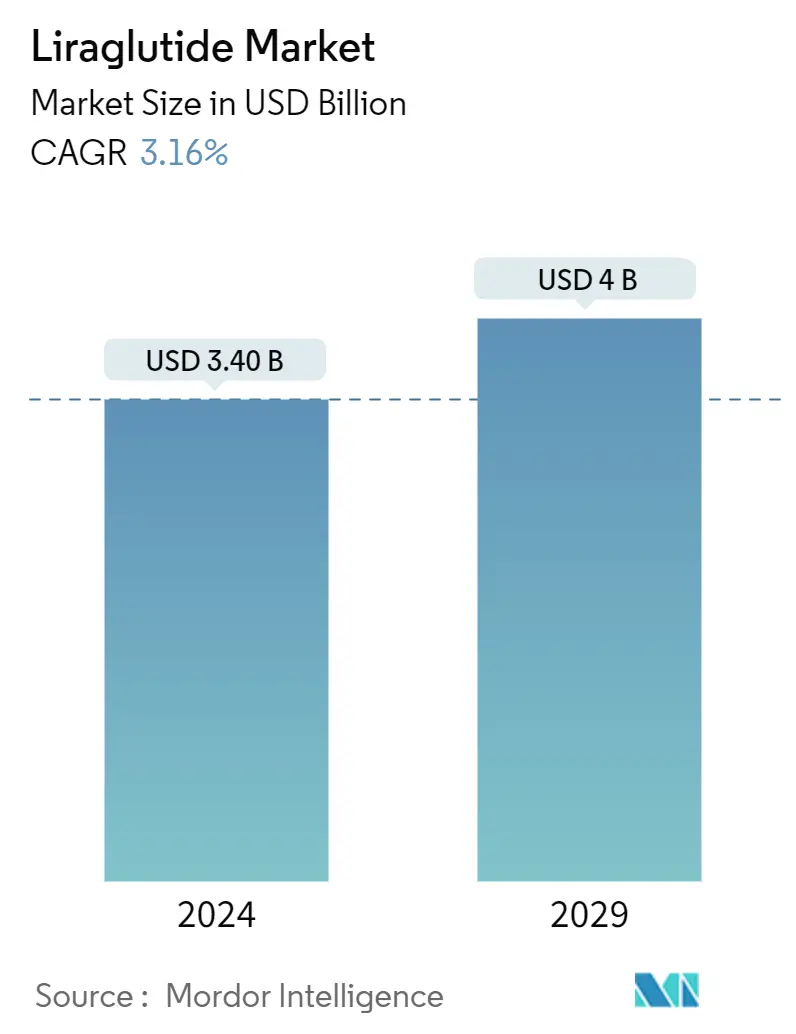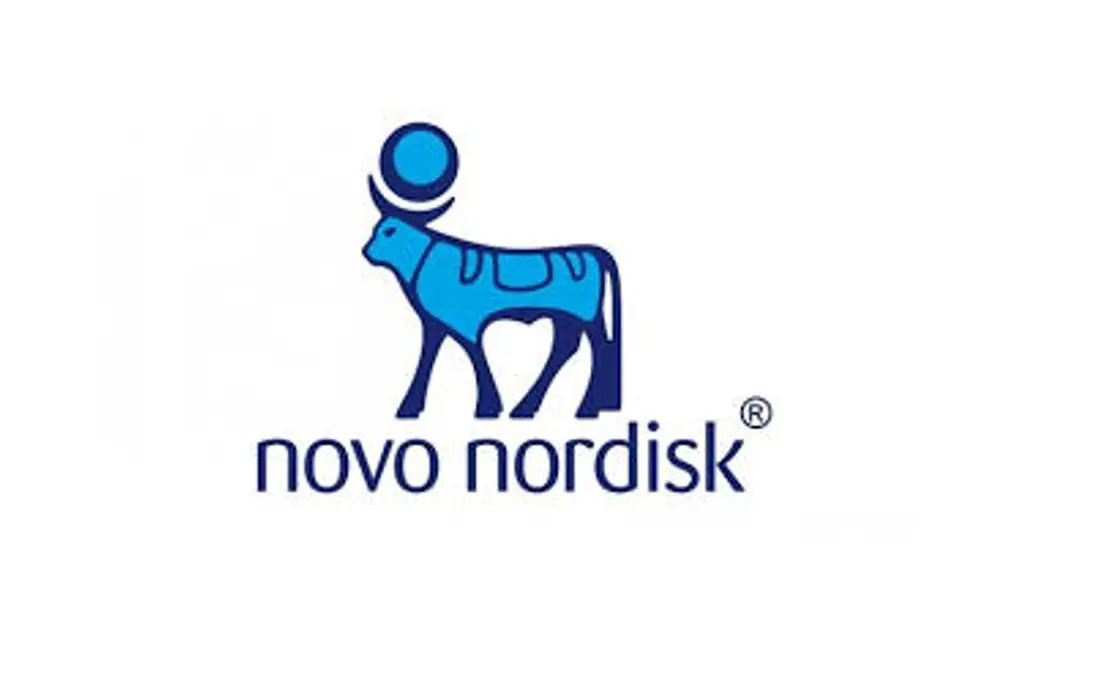Market Size of Liraglutide Industry

| Study Period | 2018-2029 |
| Market Size (2024) | USD 3.40 Billion |
| Market Size (2029) | USD 4 Billion |
| CAGR (2024 - 2029) | 3.16 % |
| Fastest Growing Market | North America |
| Largest Market | North America |
Major Players
*Disclaimer: Major Players sorted in no particular order |
Liraglutide Market Analysis
The Liraglutide Market size is estimated at USD 3.40 billion in 2024, and is expected to reach USD 4 billion by 2029, growing at a CAGR of 3.16% during the forecast period (2024-2029).
The COVID-19 pandemic co-morbidities included hypertension, diabetes, cardiovascular disease, and cancer. According to an article,” 89-LB: COVID-19 Outcomes in Patients Who Started GLP1-RAs during Hospitalization,” published by the American Diabetes Association in June 2022, glucagon-like peptide-1 receptor agonists (GLP-1 RAs) were considered beneficial in improving COVID-19 outcomes due to their anti-inflammatory properties. Patients admitted for severe interstitial bilateral pneumonia in the COVID-19 ward due to SARS-COV2 infection and having type-2 diabetes or in-hospital hyperglycemia were treated with GLP-1 RAs in addition to standard therapy.
Furthermore, the Centers for Disease Control highlighted that COVID-19 was a serious public health threat for people with serious chronic diseases, including diabetes. People with diabetes were more likely to experience complications when infected with the virus. As per the American Diabetes Association, people with diabetes, if uncontrolled, had worse outcomes if infected with a virus such as COVID-19. The International Diabetes Federation explained that when people with diabetes develop a viral infection, it can be harder to treat due to fluctuations in blood glucose levels and diabetes complications as the immune system is compromised, making it harder to fight the virus and likely leading to a longer recovery period.
Liraglutide is a glucagon-like peptide-1 (GLP-1) receptor agonist used to treat type-2 diabetes and chronic obesity. It is used when diet and exercise alone do not result in good blood sugar control. It is a second-line therapy for diabetes, following first-line therapy with metformin. It is also used to help reduce the risk of heart and blood vessel problems, including heart attacks and strokes in patients with type-2 diabetes and established heart or blood vessel disease. Liraglutide is sold under the brand names Victoza and Saxenda.
The World Health Assembly Resolution 2022 recommends the integration of prevention and treatment of diabetes into primary health services, the development of pathways for a substantial increase in access to insulin, the promotion of convergence and harmonization of regulatory requirements for diabetes medicines and technologies, and improved diabetes monitoring and surveillance. Furthermore, it involves the WHO to advise the Member States to ensure the uninterrupted treatment of people living with diabetes in humanitarian emergencies. This important milestone provides a global mandate for diabetes efforts for the next decade.
Major factors that are expected to boost the growth of the studied market in the forecast period are rising obesity and inactivity rates among people, which have resulted in an increase in the diabetes population over time, a rise in the sedentary lifestyle, improper dietary patterns, and the inherent history of diabetes disorders. In addition, rising investment in research and development, technological developments, and new product launches will further provide potential opportunities for the growth of glucagon-like peptide 1 (GLP-1) agonists over the forecast period.
Liraglutide Industry Segmentation
Liraglutide, sold under the brand names Victoza and Saxenda, is an anti-diabetic medication used to treat type 2 diabetes and chronic obesity. The Liraglutide market is segmented into brands (Victoza, Saxenda) and geography (North America, Europe, Asia-Pacific, Middle East and Africa, and Latin America). The report offers the value (in USD) and volume (in units) for the above segments.
| Brand | |
| Victoza | |
| Saxenda |
| Geography | |||||||||||||
| |||||||||||||
| |||||||||||||
| |||||||||||||
| |||||||||||||
|
Liraglutide Market Size Summary
The Liraglutide market is poised for steady growth over the forecast period, driven by increasing obesity rates and the rising prevalence of type-2 diabetes and cardiovascular diseases. As a glucagon-like peptide-1 receptor agonist, Liraglutide plays a crucial role in managing these conditions, particularly when lifestyle modifications and first-line therapies like metformin are insufficient. The drug is marketed under the brand names Victoza and Saxenda and is integral in reducing the risk of heart-related complications in patients with established cardiovascular conditions. The market's expansion is further supported by advancements in research and development, technological innovations, and the introduction of new products, which are expected to create significant opportunities for growth in the glucagon-like peptide-1 agonist segment.
The North American region currently holds a significant share of the Liraglutide market, attributed to the high prevalence of diabetes and obesity, exacerbated by lifestyle changes and dietary habits. The market is characterized by a lack of generic alternatives, with Novo Nordisk A/S maintaining a stronghold. Recent partnerships and strategic agreements, such as Biocon's collaboration with Juno Pharmaceuticals for the Canadian market, highlight ongoing efforts to expand the drug's reach. Additionally, the market dynamics are influenced by public health initiatives and regulatory support aimed at integrating diabetes prevention and treatment into primary health services, further bolstering the demand for Liraglutide.
Liraglutide Market Size - Table of Contents
-
1. MARKET DYNAMICS
-
1.1 Market Overview
-
1.2 Drivers
-
1.3 Restraints
-
1.4 Porter's Five Forces Analysis
-
1.4.1 Bargaining Power of Suppliers
-
1.4.2 Bargaining Power of Consumers
-
1.4.3 Threat of New Entrants
-
1.4.4 Threat of Substitute Products and Services
-
1.4.5 Intensity of Competitive Rivalry
-
-
-
2. MARKET SEGMENTATION
-
2.1 Brand
-
2.1.1 Victoza
-
2.1.2 Saxenda
-
-
2.2 Geography
-
2.2.1 North America
-
2.2.1.1 United States
-
2.2.1.2 Canada
-
2.2.1.3 Rest of North America
-
-
2.2.2 Europe
-
2.2.2.1 Germany
-
2.2.2.2 Spain
-
2.2.2.3 Italy
-
2.2.2.4 France
-
2.2.2.5 United Kingdom
-
2.2.2.6 Russia
-
2.2.2.7 Rest of Europe
-
-
2.2.3 Asia-Pacific
-
2.2.3.1 Japan
-
2.2.3.2 China
-
2.2.3.3 Australia
-
2.2.3.4 India
-
2.2.3.5 South Korea
-
2.2.3.6 Malaysia
-
2.2.3.7 Indonesia
-
2.2.3.8 Thailand
-
2.2.3.9 Philippines
-
2.2.3.10 Vietnam
-
2.2.3.11 Rest of Asia-Pacific
-
-
2.2.4 Latin America
-
2.2.4.1 Brazil
-
2.2.4.2 Mexico
-
2.2.4.3 Rest of Latin America
-
-
2.2.5 Middle East and Africa
-
2.2.5.1 South Africa
-
2.2.5.2 Saudi Arabia
-
2.2.5.3 Oman
-
2.2.5.4 Egypt
-
2.2.5.5 Iran
-
2.2.5.6 Rest of Middle East and Africa
-
-
-
Liraglutide Market Size FAQs
How big is the Liraglutide Market?
The Liraglutide Market size is expected to reach USD 3.40 billion in 2024 and grow at a CAGR of 3.16% to reach USD 4 billion by 2029.
What is the current Liraglutide Market size?
In 2024, the Liraglutide Market size is expected to reach USD 3.40 billion.

